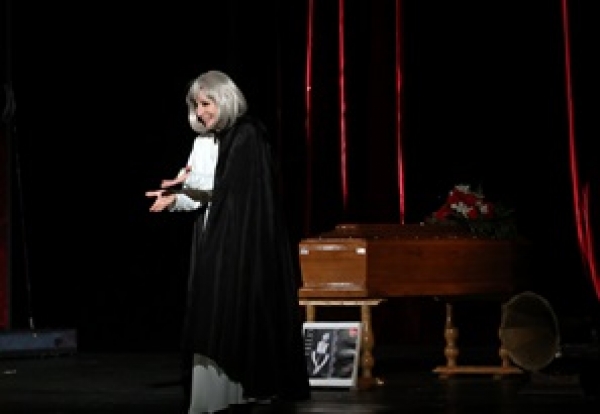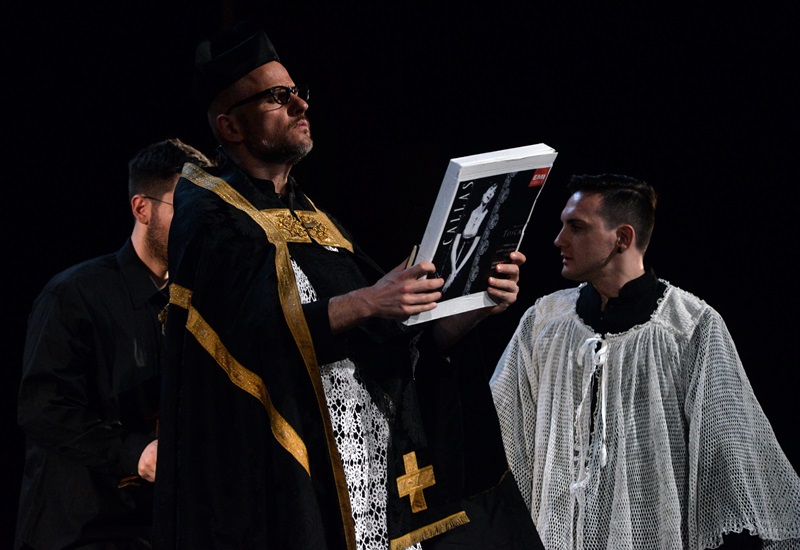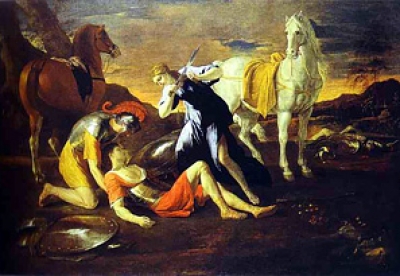A one-act opera called The rival (La rivale) by the contemporary Italian composer Marco Taralli was presented at the Bartók Plus Opera Festival. Its premiere took place about a year and a half ago in Novara, Italy.
La rivale is a comic opera, but at the same time a comedy with bittersweet nostalgy and irony. The main character is Carmela Astolfi (a fictitious person), an old diva, the former rival of Maria Callas, who returns to her country after several years. During her visit to the museum of La Scala in Milan she is shocked to find that while she was forgotten, her rival remained the greatest soprano of all time in the memory of fans. The museum's guide is also gushing about La Divina to the young visitors, who know almost nothing about opera. The young salesgirl of the Scala record shop is not very competent, either, she does not even know Puccini's name. For the outraged Carmela she finally comes up with a recording of Madama Butterfly – with Maria Callas in the title role, of course. (It seemed to me, that the vocal part of the lay salesgirl parodies the coloraturas of the Queen of the Night. I wonder what the composer thinks about Mozart ...)
photo: János Vajda
By the recollections of Carmela, the once celebrated diva, we go to the past, flying over 60 years back in time: on the stage now we can see the young Carmela and her lover as they are watching a performance of Traviata in their theatre box in La Scala. For a few seconds, we can hear Callas, too. (The recording of the finale from the legendary 1955 performance directed by Visconti; the characters in La rivale are also talking about this particular production.) Much to Carmela’s despair, the singing of Callas sweeps off her musically incompetent admirer’s feet, as well.
Back to the present: in the museum's café Carmela at last finds companion of the same age with a man called Antonio Melomaniac. Together, they recall some great performances of the past. The more desperate it is for the woman, when it turns out, that the man also worships Callas. The diva clutches her heart and falls dead. In the closing scene, accompanied by the beautiful, painful melodies of the orchestra, a priest appears and a coffin is brought in: we are at Carmela's funeral. We hear a few bars on the piano from Tosca's prayer, and then the aria continues in Callas's voice. Antonio comes in and eagerly volunteers to put Callas's image in front of the coffin, and recommends that Callas's voice be played on the funeral, as Carmela certainly loved her ... The end of the work is a morbid gag. Carmela's ghost comes in and tells the conductor angrily: now it is her turn at last and then she sings a high note. ’Eh!’ – she cries to the coffin and walks out.
photo: János Vajda
La rivale is a chamber opera with a small symphony orchestra and a piano. Therefore, it is best to perform it in small theatres.
The scenery is simple: we see the interior of the museum, a bookshelf with records, costumes, relics, and a theatre box in the past scene. Unfortunately, this did not prove to be enough, and the director used very few tools as regards stage technology. This slightly boring stage scenery lowered the quality of the performance; overall, we saw a quite uncreative stage direction. Of course, it is possible to do such a "minimalist theater’, but then this must be offset by the outstanding vocal performances (they were not outstanding) and / or by the quality of the music. Although La rivale is a skillfully composed piece, I would not call it a masterpiece.
photo: Mihály Samu Gálos
In addition to the Traviata recordings, there are several musical quotations and references in this work, which the composer uses finely and never aggressively. Rather, he only gives us a feel of the atmosphere of Puccini’s and Verdi’s musical world, both in the orchestral and in the vocal parts, avoiding pretentious solutions. The old recordings fit smoothly into the melodic music of the opera. The beautiful violin chords at the beginning of the work reminded me of the Overture of Traviata. La rivale works well from the point of view of dramaturgy, it has a clever libretto, but in this production we heard mediocre vocal performances, albeit the singers were acting well. (The best voice was the bass Daniele Cusari in the role of Antonio. Anyway, the performers and the creators were almost identical with those of the premiere. The title role was then and now sung by Tiziana Fabbricini, who interpreted Violetta in La Scala in 1990. That was an important performance since on that night the Milanese theater staged Verdi's opera for the first time in 26 years. It seems that after Callas it was difficult to continue...)
We hear very few self-contained musical numbers, though the action is sometimes interrupted by a duet or a monologue. The text contains a number of small, funny references, which may not be comprehensible immediately for everyone. For example: the name of Carmina’s young caregiver is Annina, the same as the name of Violetta’s servant in Traviata. Another example: in the cafeteria, the characters ask for Martini and Rossi (the ’Martini e Rossi’ concerts were very popular in the 1950s in Italy).
photo: Mihály Samu Gálos
No one escapes from some mocking remarks in this work. Through Carmela's criticism, even Callas herself gets hers (’she was not the most beautiful voice’, ’she burned out too early’ etc.), but her fanatic fans and the people making a business of her, get even more criticism (Antonio wants to present a Callas Award to Carmela on the Callas Day in the Callas Hall...). The author makes Carmela, the ’tortured artist’ ridiculous, but also reminds us that many singers became undeservedly forgotten in the shadow of some unduly publicized stars. He thinks bitterly of the rapping young people in the museum for whom the genre of opera is unfamiliar, but, at the same time, looks at the ever-nostalgic Carmela with irony (she can only talk about ’the good old days’). A certain type of the operatic core audience (the ’cliques’) are also mocked: Carmela's lover first shouts ’brava’ at the end of Traviata, and then, when his interest so requires, he starts to ’boo’ (because Carmela asks him to do that).
photo: Mihály Samu Gálos
La rivale is not a masterpiece, but a well-written, witty and smart musical sketch, which is entertaining and even makes us think. It was a good idea to present it here in this Festival, but it is a pity that due to the not very imaginative stage direction and the mediocre vocal performances, only part of the values of this work could be revealed this evening.
Balázs Csák
***
Marco Taralli:
Libretto: Alberto Mattioli
Cast:















